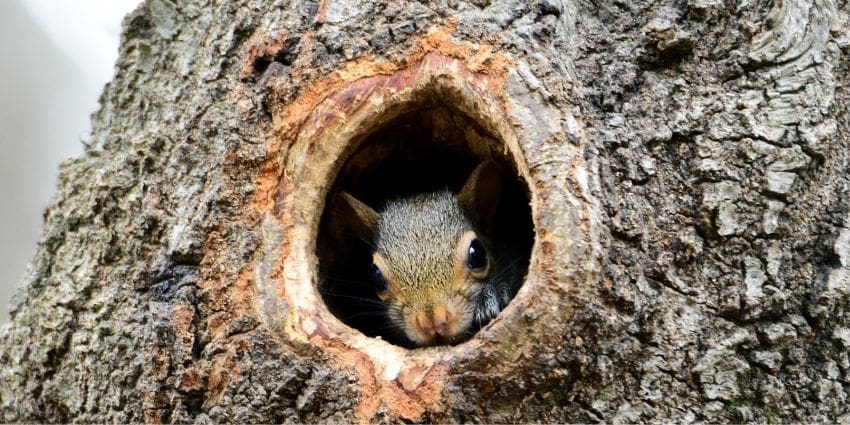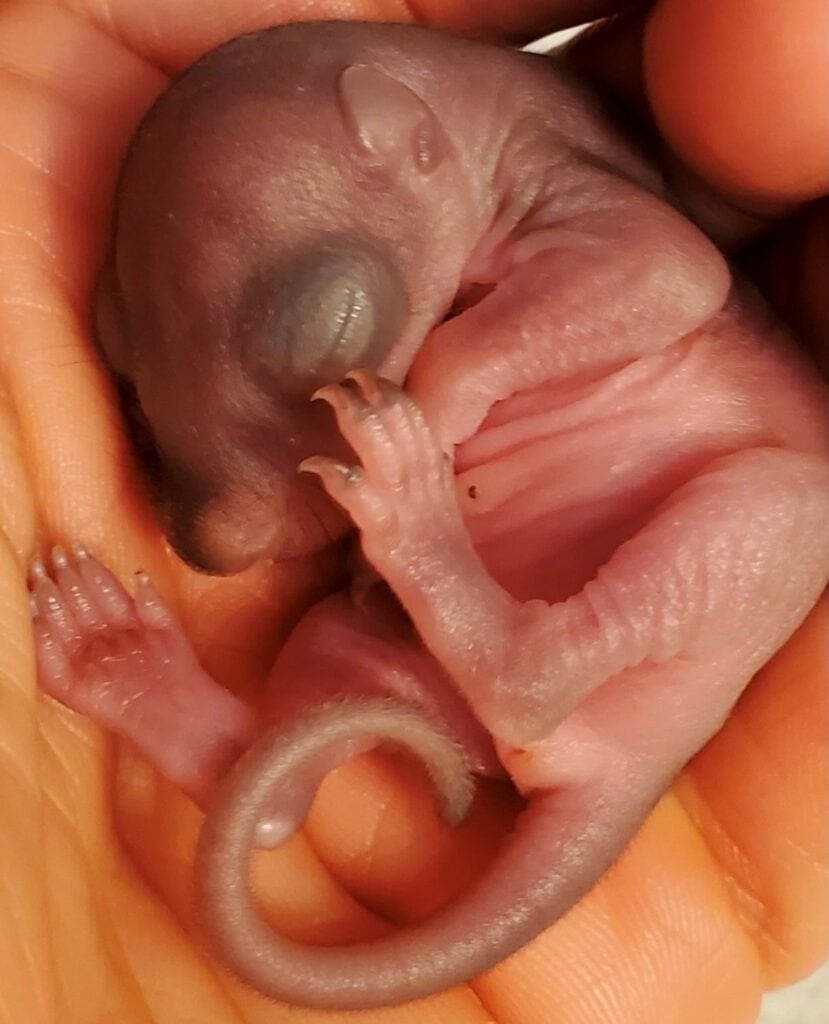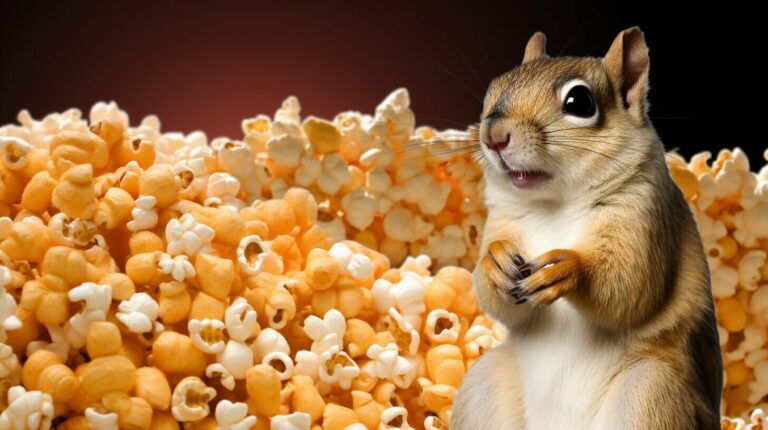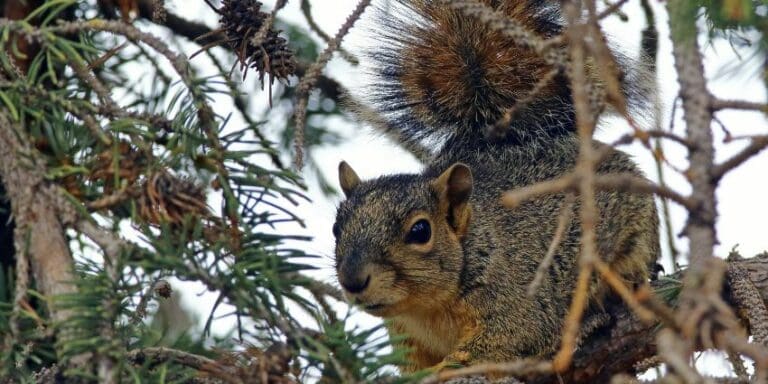Baby Squirrel Feeding Chart – An Ultimate Intro to Foods
Are you looking for an introduction to foods for baby squirrels? Read on for the ultimate food intro guide recommended by an expert squirrel rehabber! Our Baby Squirrel Feeding Chart is an excellent resource for rehabbers, squirrel owners, and wildlife rehabilitators to introduce new foods to baby squirrels. We also provide in-depth information about what age is suitable for different foods.

Disclaimer: If you find a sick, injured, or orphaned animal, please don’t take on the responsibility of caring for it yourself. Please locate a licensed rehabber in your area, and remember, this is about the animal’s one chance at life.
Looking for a Rehabber? Here are 3 Resources
- Squirrel Rehab Locator Map – input your zip code or city into the search bar of Google Maps.
- Animal Help Now – licensed rehabber directory
- Squirrel Connections – licensed rehabber directory by state
Baby Squirrel Feeding Chart: Feeding Tips
The baby squirrel feeding tips are the best practices of Karen C., an expert rehabber in New Orleans, LA. If you want to connect with Karen, message her on her Instagram @omakoda.
Formula
Squirrels need a quality formula from birth through self-wean, usually at 12 to 14 weeks of age.
Water
Fresh drinking water is available as soon as the squirrels open their eyes, usually around 5 weeks old. My preference is to expose the squirrel to water, even though squirrels may not begin to drink water for one to two weeks after opening their eyes.
Rodent Blocks
Starting daily at 4 weeks of age, Karen places a fresh piece of rodent block in their feeding dish. The squirrel gets accustomed to the smell by having a new piece daily. They may not eat the block immediately but begin to gnaw on it.
Rodent blocks are offered daily while the squirrel is in Rehabber Karen’s care. At the age of 8 weeks, the serving increases to two (2) blocks per day.
Solid Food
When squirrel babies open their eyes, Karen offers solid food. When she first began rehabilitating squirrels, she witnessed babies having diarrhea and bloat. These unfortunate circumstances led her to develop a system to introduce new foods. This series of introductions work for Karen, and individual results may vary.
How Old are Squirrels When They Open Their Eyes?
Squirrel species can vary in their development, but most baby squirrels open their eyes around 4 to 5 weeks of age. At birth, squirrels are hairless, blind, and helpless, relying on their mother’s care for nourishment and protection. As they grow, they develop fur, gain mobility, and eventually open their eyes. Once their eyes are open, they become more aware of their surroundings and start to venture out of the nest and explore, typically around 6 to 8 weeks of age.
Baby Squirrel Feeding Chart 5 to 8 Weeks Old: Introduction to Vegetables & Fruits
Vegetables
At 5 weeks old, or when eyes are open, the squirrel is introduced to vegetables. Karen offers one kind of vegetable at a time. If there are no issues after 24 hours, another veggie is introduced. If any vegetable causes problems like diarrhea or bloat, the veggie is discontinued and introduced later.
Cut vegetables into big chunks to avoid choking. Continually monitor when introducing new foods.
Fruits
5 to 8 weeks old
The only fruit offered during this time (5 to 8 weeks old) is avocado. Most squirrels LOVE avocados. Avocados can cause choking because the squirrels become overzealous and put too much in their mouth.
Cut avocado into thin slices and hand-feed due to possible choking hazards. Please remember to Continually monitor when introducing new foods.
| 5 to 8 weeks old: Vegetables & Fruit Introduction |
|---|
| Arugula |
| Beet greens |
| Belgian endive |
| Broccoli |
| Brussels sprouts |
| Butternut squash |
| Carrots |
| Cauliflower |
| Collard greens |
| Crookneck squash |
| Cucumber |
| Garbanzo beans (fresh) |
| Kale |
| Pumpkin |
| Radicchio |
| Romaine lettuce |
| Sugar snap peas |
| Sweet potatoes |
| Swiss chard |
| Turnip greens |
| Zucchini |
| 5 to 8 weeks old: Fruit Introduction |
| Avocado |
Subscribe to the Free VIP Squirrel Scoop Insider Magazine
Written by none other than Bart the Balcony Squirrel, this lighthearted take on life and current squirrel-related world events is sure to bring a smile to your face. From his perch on the Kitty City Squirrels balcony, Bart brings a unique and entertaining perspective to every issue. Why wait, Subscribe now!

Baby Squirrel Feeding Chart 6 to 7 Weeks Old: Introduction to Nuts
Shelled Nuts
Karen introduces shelled almonds and pecans at 6 to 7 weeks old. One piece is given as a bedtime treat.
Unshelled Nuts
Introducing unshelled nuts to squirrels is tricky due to nut aggression. Karen saves unshelled nuts when the squirrels get transferred to the release enclosure. When in the release enclosure, Karen stops handling the squirrels.
Nuts in the shell can turn squirrels into little devils. If you’re not worried about nut aggression, then 6 to 7-week-old squirrels can have 1 to 2 nuts, NO more than that if the squirrel is captive.
Baby Squirrel Feeding Chart 8 to 9 Weeks Old: New Fruit Introductions
Fruit
Karen offers apples to squirrels at 8 to 9 weeks of age. If there are no issues after 24 hours, feed blueberries, followed by grapes. Please remember to give only one type of fruit at a time. If there are no problems, continue with other varieties like blackberries, cantaloupe, cherries, coconut, cranberries, citrus, kiwi, persimmon, pomegranate, raspberries, etc., watermelon.
Lesson Learned
During a volunteer rehab shift, Karen witnessed an 8-week-old squirrel struggling. A piece of apple skin was stuck to the squirrel’s palate, and removing the skin took two people. They considered themselves lucky to be there during that emergency and used it as a lesson learned.
Remove apple and grape skins until the Squirrel is 10 weeks old or until you are sure it can handle it Without choking.
| 8 to 9 weeks old: Fruit Introductions |
|---|
| Apples (introduce first & remove skin) |
| Blueberries |
| Grapes (remove skin) |
| Blackberries |
| Cantaloupe |
| Cherries |
| Coconut |
| Cranberries |
| Citrus |
| Kiwi |
| Persimmon |
| Pomegranate |
| Raspberries |
| Strawberries |
| Watermelon |

Baby Squirrel Feeding Chart 9 to 10 Weeks Old: Animal Protein Introductions
At 9-10 weeks old, the squirrels are fed animal protein. This includes dried grasshoppers, crickets, live or dried mealworms, and live moths. Please note that not all squirrels are into these, but giving them a try is a good idea.
| 9 to 10 weeks old: Animal Protein Introductions |
|---|
| Dried grasshoppers |
| Dried crickets |
| Live or dried mealworms |
| Live moths |

Baby Squirrel Feeding Chart 9 to 10 Weeks Old: Wild Food Introductions
Squirrels love wild foods offered at 9 to 10 weeks of age. As a rehabber, Karen’s job is to familiarize the squirrels with some of the local area’s natural foods. If you are a rehabber, have a captive or non-release squirrel, consider educating yourself on wild edibles.
The following list I offer includes: branches with lichen, camellia buds, oxalis (all parts), pine cones, rosebuds, rose hips, white clover (all parts), wild hibiscus, etc.
| 9 to 10 weeks old: Wild Food Introductions |
|---|
| Lichen branches |
| Camellia buds |
| Oxalis (all parts) |
| Pinecones |
| Rosebuds |
| Rosehips |
| White clover (all parts) |
| Wild Hibiscus |
Conclusion
One of the most important things to know when caring for baby squirrels is what they need to eat. The diet a baby squirrel requires is complex. Learning to feed a baby squirrel can be daunting, but it doesn’t have to be. If you have tips or tricks that have worked for you when feeding baby squirrels, send Kitty City Squirrels a message or leave a comment below.
Looking for a Rehabber? Here are 3 Resources
- Squirrel Rehab Locator Map – input your zip code or city into the search bar of Google Maps.
- Animal Help Now – licensed rehabber directory
- Squirrel Connections – licensed rehabber directory by state






What invaluable information here! Thank you very much.
Hi Kathe,
Thank you so much for leaving this feedback. Makes me feel good to know that you found value in the information. Karen, the rehabber was so gracious to put the core information together for me to help others. Thanks again!!
They really have a complex diet!! Thank you for sharing and Thank you Karen for helping so many babies squirrels ❤️
Thank you, Viviane for taking the time to read the article. When Kitty City Squirrels branches out with a Fan Club, you will be the CEO!!!! Many thanks.
Fantastic guide for begginers or finders, who might find it difficult, or impossible, to locate a licenced rehabber. Like us here, in UK, where greys are illegal to keep (and, ironically, release – are we supposed to just let them die, where they are? I don’t think so) & rehabbers few & far between.
We don’t have blocks in shops but the squirrels don’t seem to mind, as long as calcium reach foods are implemented & regularly offered.
We have to improvise. But, where there is a will, there’s away! And every little helps… we very much like a carefully put together dietary plan for young squirrels & new carers.
Thank You!?
Yes Kasia, I had another rehabber reach out to me that suggested I include calcium requirements on all dietary articles. I will be including that valuable and life-saving information. The laws in the UK are not in favor of the Greys and seem cruel. 🙁 Thank you for all you do for the Greys in the UK.
When I fell into rehabbing squirrels about 6 years ago info like this article would have helped immensely! I knew nothing and there were no rehabbers that would take my baby. I was more than happy to assist kittycitysquirrels with this article. Hoping this info helps those who are interested.
Thank you so much, Karen, for contributing your valuable knowledge to help others in the future. Just today, I had a message from another rehabber in Florida that recently had an incident with a squirrel almost choking on grape skin. Thankfully like you, she was there to intervene. She said it only takes once to learn not to make that mistake again. This information is essential because you may save numerous squirrels by sharing your experience with others. Kitty City Squirrels thanks you immensely and look forward to more trusted rehabber knowledge from you.
This article has valuable information even for squirrels living in a backyard tree. Most of the time my squillys do their squirreling on their own as far as veggies are concerned. Eating tree leaves, grasses, and dandelions. They know what they need best. But, since there are no local fruit trees or vines, I’ve noticed that if I set out some fruits, (grapes, blueberries, avocado, or the occasional peach and then pumpkin in the fall) they seem to enjoy the additional yummies to their diets.
Wow, what a variety you offer your backyard babies! Mine, as you know 🙂 go for grapes, blueberries, avocado, and cherries. I shall give peach and pumpkin a try! @omakado did a wonderful job helping me with the valuable information in this article! Thanks so much for reading and supporting Kitty City Squirrels.
This is a wonderful article, and I’m glad to see the way I have been introducing new foods has been a good method! However I was wondering, how many peices of vegetables would you give them a day, based on weight or age? I’ve got a 7 week old eastern grey, and he’s small for his age, should I be overly concerned about offering him too many vegetables; or will he sort that out himself? He loves the veggies I’ve been giving him, I just want to make sure I’m not offering him too much. Today I gave him one rodent block and 4 peices of vegetables. Not huge peices, maybe the size of my thumb or a little less. (He gets one nut per day right now, an almond or hazelnut. I wait until the end of the day so that I know he’s eating his other foods throughout the day and not being picky and only wanting the nut)
Hello Lena, Thank you very much for your comment. I also sent you a direct email with Rehabber Karen’s response which is also posted below. Many thanks, Maddy
Lena,
We’re so pleased to know that the squirrel feeding article is helping you raise your little one. I would recommend offering more than 4 pieces of food. I’d probably double the pieces offered, plus add a couple of green leafy veggies. Continue with the rodent block. You will have waste. That’s just part of raising a squirrel. Because you mentioned your baby is a bit on the small side, I’d make one of those pieces be avocado because of its high fat. ***Monitor their intake of avocado, especially the first few times you give it. As I mentioned in the article, they can become overzealous and choke. Sounds like you’re doing a great job!
Good luck,
Karen Carpenter
Your article is great and thank you. Here is my story of the little orphaned squirrel I found:
“My cat found a baby squirrel, which had fallen from a tree. It looked dead and cold, but when I picked him up he still moved… I took care of him and after 2 weeks he is doing very well, he has a bushy tail and is supper strong with sharp claws. I think it is time to buy a cage to keep him until next spring when he is able to fend for himself. He is still on Esbilac formula every 4 hours. Need to start on solid food, maybe avocados. Any additional advice, which could help me?
Thank you Sylvia,
I emailed you as well as Karen the author of the article regarding your questions. Thank you so much for supporting the website. Maddy
Wonderful article. I was looking up when you introduce fresh drinking water to my baby squirrel. His eyes opened yesterday. After every meal I wipe him down with a wet napkin to remove any spilled milk or urine off of him. I noticed he licks the napkin everytime I use it. Should I try offering water in the syringe, a dish of water in the enclosure, or a rodent bottle water that goes on the side of the cage? In the past I used the syringe but I was wondering if there is a better option so he can stay hydrated on his own terms.
Hello Ashley,
Thank you for your question and I have sent your message to Karen and I am awaiting a reply. Will let you know when I hear from her.
Maddy
What can I do with a baby squirrel I think is about 5-6 weeks old. My dog was playing with it this morning and it does seem to be injured. Looks like puncture wound to mid side and maybe small puncture on the head. Little bleeding earlier now none. Sleeping most of the time but is aroused and frightened when I check on it. Doesn’t stand on back legs but does scoot around in box.
No wildlife rescue/rehab in area. What should I do?
Connie,
Thank you for reaching out to Karen, the squirrel rehabber!
I would like to know the symptoms of bloated belly. Since the baby squirrel looks healthy and is having good excretion but today I noticed that the belly looks a little plump. I feel like it’s a bloated belly so I searched for remedies and followed through but it’s still like this. I am worried it may harm the baby. Please reply me back soon so I can help it.
Hello Ishika,
I sent you an message.
Maddy
I found a baby squirrel about 5-6 weeks I think am feeding him every 2 n 1/2 hours trued feeding a piece of peeled apple but was not interested going to get a cage so he can move around more how do I release him into the outside again n when do I know
Hi Nina,
I sent you an email from Kitty City Squirrels!
Maddy
I want information on feeding a newborn baby squirrel milk.
Is it a product or something that needs to be handmade?
Additionally, is it possible to trigger diarrhea or bloat when I feed the milk to the baby?
Hello! Thank you for reaching out. I emailed you from [email protected]
Thank you,
Maddy
Hello,
I live in the Lakes Region in NH and for about a week now have been caring for a baby squirrel that must have fell from a nest. He was crying for help and when I approached him he ran right over to me and up my pant leg all the way to my hair, then jumped off me and did it again! I took him in and have been keeping him warm because he really seems to hate being chilly at all. I tried to put him in a tank with warm winter hat, cut up piece of my clothing and he will just freak out the entire time until I pick him back up. He goes inside my shirt and seems to favor sleeping on my chest by my heart. He doesn’t play much at all and I’m also nervous to let him just run around. I feed him a puppy replacer milk because that’s what I read online but everything I read is so contradicting and confusing so I am not sure I am doing this right. I could use some advice on what exactly to give him and the amounts. He drinks it and stops every time around 1 and half ccs of the mixture made with one teaspoon of the formula and two teaspoons of warm water. I have issues getting the milk out of his hair after nothing seems to work except actually bathing him in warm water and drying him after as quick as possible. But I do this also to help with his bathroom business clean up since I have been stimulating after every single feeding. His poop went from black to now mustard yellow/brown pellets or balls. I think based on what I read he is about 5 or 6 weeks old but I am not sure. He is eyes open, can run around and stand on back legs somewhat, and has his front teeth. He first had only the bottom but the other day got the top. I noticed because he bit me during bath time and it hurt more than the first day, LOL. I did offer a walnut and a hazelnut the other day but he didn’t take it. He did try to drink some water from a bowl and then from a bottle feeder type. He is a beautiful eastern grey squirrel. I just want to do things right and make sure I am not hurting him in anyway. Any advice would be greatly appreciated since I am so new to this. Sorry for the long comment but I thought the details would be important. Thank you!
Hello Valene,
I replied via email to your from the Kitty City Squirrels email.
Thank you,
Maddy
I have 2 boys Ren and Stempy I have had them since they were 5-weeks old they seem to be doing well however I have been raising them on exotic nutrition squirrel complete and giving them fresh vegetables every day but One of my boys seems to be loosing his hair his tail looks sparse while his brothers looks very full I just want to make sure I am doing everything I can to make sure there healthy I thought maybe mites but wouldn’t his brother also be infected if that was the cause
Hello Dawn,
I sent you an email! Check your “junk mail” if you don’t see it in your inbox!
Thank you,
Maddy